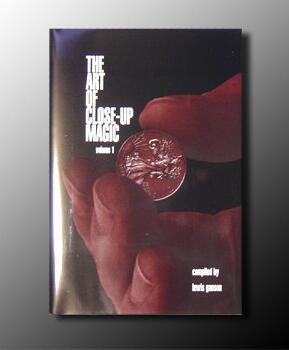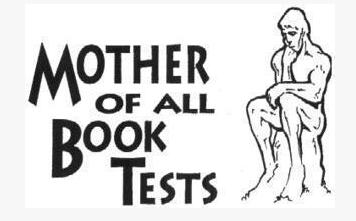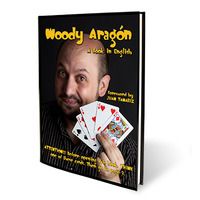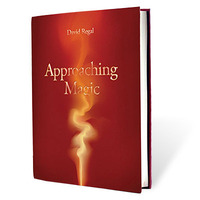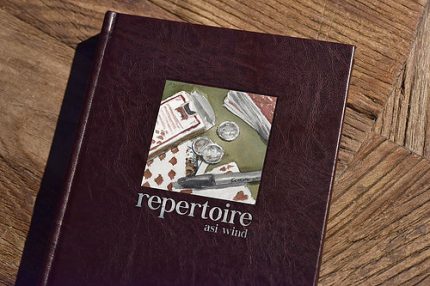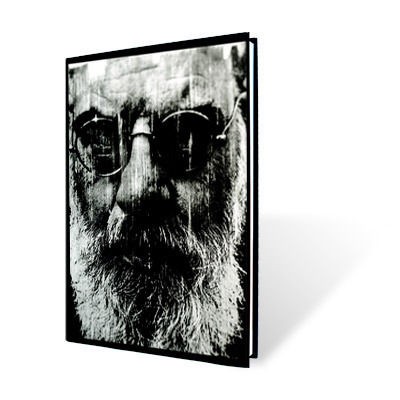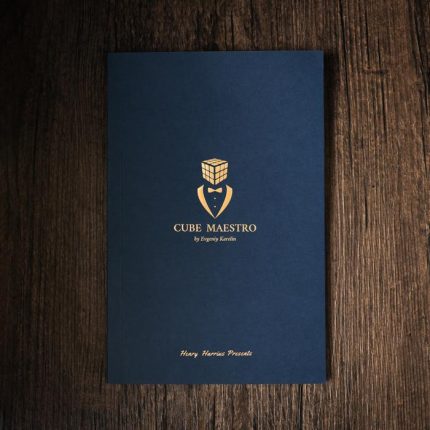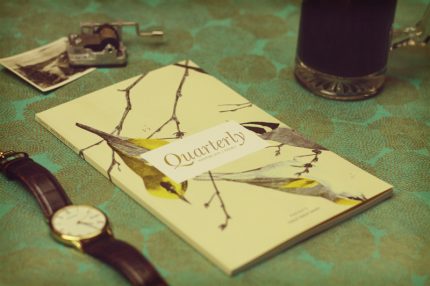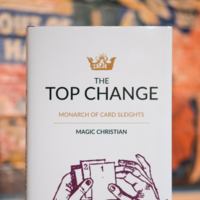Comments (magicref): Well written close up magic by many contributors. There is no card magic in the bunch except as props. Each effect is well thought out and fully described with lots of practical advice. Each effect has been worked so that it can be performed. Some of the effects are performed using magic props that are available from dealers, most don’t need anything special. In a few cases I’m not sure if the props are still available. Clear line drawing are provided where needed. Some of my favorites include: 53-85 Okito Box effects; 87 Loop Chain; 103 Shell Game (need walnuts); 113 Purse Swindle (need 3 purses); 118 Phoenix Pound: load folded dollar into envelope; 131 Paddles; 150 Color Change Knives; 174 Dual Control Pencil; 195 Ringer ring on wand/linking ring effect; 200 Thimble box: magnet/nesting thimbles; 208-231 Coins alone; 232 Cylinder & Coins (pivoting stack); 282 Imp Bottle; 316 Gozinta Pencils; 324 3 Little Pigs; 335 Beer Mats & Coin; 344 Sponge Ball Routine; 354 Chinese Bowl: Benson Bowl type. See Bruce Elliot’s Classic Secrets of Magic; 369 Jardine Ellis Ring
Contents: (The short descriptions below do not to justice to the magic contained here.)
Preface: Foreword by Fred Lowe
1 Chapter 1 – The Presentation of Close-Up Magic: essay on the presentation of magic
1 Introduction: presentation style varies depending on the size of the group
3 One Spectator
6 A Small Group
10 The Large Group
11 Containers: carrying and storing magic props
15 Working Surface: table surface, dice stacking
16 Music: Music, players, and a suggestion for a comedy bit
21 Close-Up Effects: choosing effects with a plot
22 Length of Performance: suggestions
24 Practice: suggestions
26 Economy of Movement: improving your performance
29 Borrowing: to borrow or not to borrow from the audience; also some suggestions on examination of objects
34 Chapter 2: Bangle Dangle: Presents ring and rope or silk routines.
34 Bangle Delight (Frederica and Rink): A ring becomes threaded on a rope and is subsequently magically removed. Uses a 36″ length of rope and a bracelet sized ring
39 The Traveling Ring (Raymond Hafler): Ring jumps from knot to knot on a rope. Same props as above.
42 Ring Transposition (Glen Gravett): A red ring on a yellow ribbon and a yellow ring on a red ribbon switch places under a handkerchief. Uses bracelet sized rings, 38-42″ ribbons, and a handkerchief.
47 Two Rings and a Silk (Glen Gravett): A yellow and red ring are tied on a silk. The ring selected by a spectator is instantly removed. Uses just two bracelet sized rings and a silk.
50 Ring, Rope, & Silks (Ravelle and Andree): Silks are tied to a rope and ring. The center of the rope is dropped into a hat, and the ring is dropped in. The ring is pulled out, and is linked to the rope!
53 Chapter 3: Boxes and Brass: Okito style coin box routines. Describes German Box, Okito Box, Boston Box, and Brass Coin Cap
54 German Box Routine (Jack Ganson): Six coins in box are held in a handkerchief. The coins penetrate both the box and the handkerchief and drop into the spectators hand. The box is shown empty. Uses a German Box with implanted English Penny.
59 Coins Through (Jack Ganson): As above (with a German Box), but the coins go through the table top.
60 Tea for Two (Ken Brooke): German box filled with coins is covered by a tea cup. After some byplay, the coins travel to underneath a second tea cup.
62 Okito Box Routine (Ken Brooke): Full Okito box routine using 2 coins and a box of cigarettes. Presents the “master move” as performed by Ken Brooke. Could substitute a box of cards for the cigarette pack.
72 Boston Three Step (Fred Lowe): Six English pennies and a smaller coin are placed in a Boston Box. The small coin penetrates them all, then re-appears back on top. Finally, all the coins penetrate.
80 The New Pocket Coin Trick (John Ramsay): A brass cap is placed over three coins. One coin penetrates the hand. Uses a specially gimmicked brass coin cover.
86 Chapter 4: It’s a Gamble. Routines with a gambling theme. Advice to present as a lecture-demonstration to avoid offense.
87 The Figure 8 (George Blake): Also known as Loopy Loop, Chain of Chance, and Fast & Loose, this is a gambler’s con in which the performer can seemingly control whether the spectator “catches” the loop in a string or ball-chain thrown on the table. Includes: The Move for Catching the Finger, The False Move, A Finger is Placed in Each Side of Figure 8, Laying Out the Chain with One Finger
93 Two Novel Moves (for The Figure 8): Knot off the Loop (a knot falls off the string/chain); The Ring Off the Loop (finger ring removed from string/chain)
95 Outline for a Routine (for the Figure 8): a nine-step outline with idea from Charles Kettle.
97 Triple Circle Routine (Fred Lowe): Using an idea by Jack Salvin (1952) for using three circles in the loop rather than the figure 8. Needs a 6 foot length of chain formed into a loop.
103 The Modern Shell Game (Harry Stanley): Includes basic instructions for making your own shells out of Walnuts, and how to make a pea. The routine is provided by Harry Stanley. It is presented as a demonstration as what you observed around a table at a racetrack recently, and climaxes with covering a shell with another shell and then a clear glass, and still the pea is not found.
113 The Great Purse Swindle (Frederica): Three coins are dropped in a purse. Magician offers to let the spectator buy the purse for less than the value of the coins, and it is found that the purse contains three different (less valuable) coins. This is repeated under more difficult conditions, and the entire purse disappears. Utilizes a special coin gimmick and provides instructions on how to make it.
118 The Phoenix Pouch (Pat Sprake): A borrowed bill is placed in an envelope. One of the four envelopes is selected, the others are burned. The bill is in the remaining envelope. Uses a TT.
121 Unfair Shake (Horace Bennett): A two in the hand and one the pocket type routine with dice and a dice cup, centered on a gambling story theme. The magician relates the story of an ex-gambling magician who used to switch in his own loaded dice. The “loaded” die ends up changing color and size, and by the end the gambler quits and takes a drink, that is produced from under the dice cup! Needs a padded cup to prevent talking and a variety of dice, but none gimmicked.
131 Chapter 5: Paddle Parade. Routines with the “paddle move”. First section describes how to make a paddle, and the basic move.
132 Spots and Paddle Routine (Frederica): Spots are chalked onto a paddle, and mysteriously appear and disappear on both sides.
136 Sympathetic Matches (Bento): Matches disappear and reappear on a paddle, finally to return home to their matchbox. Provides instructions on how to construct this gimmicked set.
143 Bento’s Bat (Bento): Paddle trick using a paddle with rubber bands. The idea is to use the rubber bands for other rubber band tricks, and this is a good way to introduce them.
144 Slippery Rocks (Dick Zimmerman): Uses one “stick” from a Jumping Gems effect, or you could make your own. Again, the spots jump, vanish, and reappear.
150 Colour-Change Knife Routine (Niberco): A two knife routine using a gimmicked knife and a regular knife of a completely different color. There are thus two color changes, and you are left clean at the end. (good)
153 Simplex Knife Routine (Rink): A three knife routine using a gimmicked knife and two regular knives. The colors of the gimmicked knife match each of the two regular knives. For example, a B/W knife, Black Knife, and White Knife. At the end, the knife under the handkerchief switches places with the knife in the pocket, and you are left clean.
157 Chapter 6: That Nut Again. Routines using the Brema Nut.
157 Brema Nut Routine (Jack Ganson): A solid nut penetrates a string. Uses the Brema Nut, and shields the moves with the performer’s body rather than with a handkerchief. Also relates an anecdote about being asked to perform this same feat impromptu!
160 Bolted (Fred Lowe): A nut can be threaded onto a bolt even though a string apparently blocks it. Needs a bolt with the center drilled out (length-wise) so that a string can be passed through it. The effect is that the string is threaded through the bolt. A nut is placed on the end of the string so it comes against the Head of the bolt and cannot be threaded on. Spectator holds one end of string and Magician holds the other, and it is raised and lowered behind the Spectator’s back. Quickly, magician “stretches” the bolt over the head so it is now found to be threaded on the bolt. (needs Brema Nut)
164 With the Brema Nut (Arnold DeSeiver): Sealed nut off ribbon routine. Performed seated (uses lapping).
168 Chapter 7: Weird Ones. Unusual routines.
168 The Thing (Dick Van Brummer and others): A ghost appears under a handkerchief lying on a table. A variation of Dik Van Brummer’s Solid Ghost, or a more modern version known as “Glorpy”. Includes an additional tip from Alan Alan.
174 Dual Control (GW Hunter and others): A pencil is rolled between the hands and suspends there. I sticks to the backs as well, with fingers spread wide. A second pencil does the same. Includes how to make the gimmick, which can also be used for other effects (see below).
182 Rising Card (Alan Alan): Use of the dual control gimmick for rising card.
184 Acrobatic Matchbox (Alan Alan): Use dual control for matchbox trick.
184 Voodoo (Albert Spackman): A stack of cards is shown with human figures drawn. One is placed in an envelope. The rest are shown to have an X marked on different places on the body. One is selected by spectator, which is found to match the prediction. With a business idea by Dennis Patten and patter by Sid Bergson.
188 A Telling Beat (Wizard Beal): Magician’s heart beat reveals cards, answers questions, and so forth. Uses a joke plate lifter.
189 Spiritune (Frederica): A tune selected by the spectator (through a card choice) plays in a music box. When the box is opened, it is found empty. Uses a small musical keychain. This effect is likely not as strong today with the advent of miniature electronic music gadgets.
195 Chapter 8: Four Gems. Four routines that didn’t fit well anywhere else.
195 The Ringer (Horace Bennett): A borrowed finger ring appears on a wand, then links to another ring, unlinks, and are inspected. Uses a more basic idea than the Himber ring.
200 Thimble Box (Bob Ostin): A thimble is removed from a box. It disappears and winds up back in the box. Features a thimble vanish and a clever box.
203 Peep-O (Dennis Patten): A word is written by a spectator on a small card. A matchbox is opened, and the inner box placed over the stack of cards with the spectator’s card on top. The cover of the matchbox is used to “see through” the inner box and the face down card to read the word, but fails. A special seeing eye card is placed on top, and now the x-ray works.
205 Colour Magnets (Norman Gilbreath): Three colored magnets only attract a disk of the same color. Magnets are touched by a white disk, and now don’t attract any of the colored disks.
208 Chapter 9: Coins Alone. Coin routines without props.
208 Coins from Hand to Hand (Horace Bennett): Four silver in right hand, four copper in left. Silver coins fly one at a time to left. Uses 4S, 3C, and a C/S coin.
212 Coins for Connoisseurs (Roger Klause): Four coins pass through table top one by one. Uses just the four coins.
217 Chinese Coins (Dai Vernon): Two rows of coins are counted in unusual manner. At each count a coin is placed in each hand, at the end, all the coins are in one hand. Uses 8 or 10 coins of any value.
219 Duplex Coin (Ken DeCourcy): English Penny changes to half-crown and back again. Repeated in a different manner. Finally, two pennies are revealed. Uses two English Pennys and on Half-Crown.
222 Four Coins and a Tumbler (Niberco): Four coins disappear one by one and appear audibly in a cup held in the right hand. Uses an expanded shell.
224 Will O’ the Wisp (Roger Klause): Uncanny slow vanish and appearance of coin. Uses a single coin and a pen or pencil for distraction.
227 Coin In a Tumbler (Ross Bertram): Glass is held in left hand horizontally with the mouth of the cup to the palm. A coin is tossed toward the bottom of the glass with the right hand, and penetrates the glass. Clever method uses a single coin and glass.
229 A New Coin Change (Dai Vernon): Silver coin placed on left hand is pressed by the right and changes into an English Penny. Uses the two coins and the English purse palm.
232 Chapter 10: Coins and Things. Coin routines with props.
232 Cylinder and Coins of Poker Chips (John Ramsay and Dai Vernon): Dai Vernon’s variation of John Ramsay’s classic effect, updated for the lay audience and featuring the use of poker chips rather than a stack of coins and using a dollar bill cylinder rather than cardboard. Could be adapted to the standard prop set as well. A cylinder made from a bill is lifted to reveal a stack of chips with a cork on top. Chips taken in one hand, the cork is covered by the cylinder. The Chips vanish one by one, to reappear under the cylinder with the cork back on top. Cork is taken in hand and the chips are covered. The chips appear in the hand, the cork is gone. The cylinder is lifted to show the chips gone and the cork there.
244 Disappearing Hole (Fred Lowe): A paper is shown with a slit. Two English pennies disappear through the hole. A silver coin appears and disappears, and the English pennies come back. An updating of Brian MacCarthy’s “Impromptu” (1939).
249 Self-Contained (Frederica): A coin vanishes and is found inside a: box in a box in a box, in a ball of wool, in a taped tumbler in another box. Does not use a gimmicked box setup, but rather depends on a sleight at the end.
253 Ganson’s Cushion (Ganson): Description and construction of a seat cushion used as a lapping aid.
255 Coins Though the Table (Ganson): Three coins go through the table to join their friends. This is repeated under more stringent conditions. Uses 6 coins, a silver ring, and makes use of Ganson’s Cushion (performed seated).
264 Migrating Pennies (Rink): 8 coins are shown in two stacks. 4 coins are covered with a box, and the other 4 with its lid. Coins travel from under the lid to under the box one at a time. Then coins vanish from the box, and reappear. They then pass through the table, and finally through the performer’s fist. This is a modification of a Professor Hoffman effect from “More Magic”, but Ganson suggests the use of an Okito box rather than metal covers. However, most of today’s Okito boxes won’t hold 8 coins.
271 Chapter 11: Big Little Tricks. Small tricks with a big impact.
271 Impromptu Pulse Meter (Roger Klause): Special instruments used to read spectator’s pulse, then broken to reveal they are toothpicks.
274 Ashes to Ashes (Roger Klause): Smudge of ashes travel through the spectator’s circulatory system to appear on the opposite hand.
277 Pin-e-tration (Roger Klause): A pin apparently penetrates spectator’s wrist without pain.
279 Easier Gypsy Thread (Norman Rhodes): A thread is broken into several pieces and then restored.
281 Black and White (Val Andrews): The old Imp Bottle expanded and improved upon. A move by Jean Poisson is provided as a bottle switch, and a routine with patter suggestion is provided.
287 Torn and Restored Cigarette (Ken DeCourcy): an impromptu quickie requiring that you have a duplicate cigarette of the brand you are going to rip into three.
289 Necklace Necromancy (Ken MacFayden): A borrowed pearl necklace is held over a glass, and the bottom of the string is cut, allowing all the pearls to fall into the glass. The pearls and string are placed in the mouth, and when pulled out, the necklace is restored. Clever use of a TT.
290 Hindu Needles (Roger Crosthwaite): Separate needles are magically threaded.
297 I.O.U. (Edward Victor): Bill in small pay envelope changes to IOU, then back, even though envelopes is “marked” with a paper-clip
301 Chapter 12: Tantalizing Tubes. Routines with various tubes.
301 Cigarette Penetration (Ganson): Cigarette placed in a tube, pins are pushed through, and the cigarette comes out unharmed. Uses a commercial brass cigarette tube.
304 Three From One (Dave Campbell): Three cigarettes appear from a small tube (uses same commercial gimmick as above)
307 The Bill Tube (Ganson): Locking Bill Tube routine. With ideas for using different brands of bill tubes
314 Arnold DeSeiver’s Routine: with the Bill Tube. Uses a special holder.
316 Gozinta Pencils (Cecil Keech): Red and Blue 3-inch pencils change places in a small tube. Uses three pencils, and a metal tube just large enough for one pencil. Utilizes some “cigarette” moves and includes an alternate ending by Fred Lowe.
324 Chapter 13: Moving Around. Objects perform transpositions.
324 Three Little Pigs (Frederica): Two in the hand, one in the pocket routine using toy pigs.
330 Capricious Corks (Hubert Lambert): Corks assemble beneath a hat.
333 Four Dice Chink-A-Chink (Bob Farrell): Dice and the dice pips transport one by one to the same corner.
335 Merely a Beer Matter (Al Spackman): A beer mat and coin routine. One beer mat is specially gimmicked.
338 Oil and Water (Eddy Taytelbaum): Red and Black backed cards when mixed keep separating themselves. Uses the Buckle Count.
344 Chapter 14: A Little Squeeze. Routines with Sponges.
344 Sponge Ball Routine (Remo InZani): Uses four large balls (1.5 inches or so) and two small half-inch ones, and a small potato and pencil. A six stage routine all in the performer’s hands (performed seated). Includes description of two fake transfers.
354 Chinese Chow (Fred Kaps): Inspired by the Roy Benson’s Bowl routine and Senator Crandall’s Cups and Balls (from Tarbell’s course). A routine using a Chinese bowl, a chopstick wand, and four sponge balls, with a lemon and orange climax.
360 Rice Bowls and Balls (Phoa Yan Tong): Another Bowl and Sponge ball routine with rubber ball climax.
369 Chapter 15: Jardine Ellis Rediscovered
369 Jardine Ellis Routine (Horace Bennett): Solid ring threads on and off a shoelace. Makes clever use of a finger ring for a surprising finish
374 Ken DeCourcy’s Sheer Simplicity: Method for removing Ellis ring from a rope.
375 Cylinder, Ring, and Cord (John Howe): Ring passes through a cord to appear under cylinder, then passes onto a wand. Two balls then appear from the cylinder. Inspired by J.G. Thompson Jr.’s routine in Top Secrets in Magic.
385 Rope, Handkerchief and Ring Mystery (Ken DeCourcy): Handkerchief is tied to a silk rope and handed to spectator. A ring is vanished, and appears under the handkerchief.
388 Tong’s Trick (Horace Bennett): Ring appears on the center of a ribbon in two mysterious ways. Uses the Jardine Ellis Ring set in a different manner than usual.
395 Finger Choice (Ken DeCourcy): Hand is shown empty. A ring suddenly appears on a finger chosen by the spectator. Does not need the gimmick.
397 Ring Appear (Ken DeCourcy): Ring appears instantly on the center of a rope (again no gimmick required)
400 Ringing the Change (J.B. Findlay): Ring vanishes and appears threaded on a napkin.
Description
Shipping & Delivery




